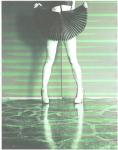- Joined
- Nov 27, 2010
- Messages
- 5,064
- Reaction score
- 4,914
- Points
- 373
- Location
- Copenhagen Denmark
- Printer Model
- Canon MP990
I have lent a niece a Canon MP540, for which I supply refilled PGI-520/CLI-521 cartridges. The printhead is new and the printer seems to be in perfect working order. The young lady is a student and needs a reliable printer for printing reports. Scanning and photocopying capability is also a must.
The day before a report was due, a print job of 200+ plain paper pages + a few A4 photos, I got a call and was told the printer had started printing strange green pictures instead of B/W. This is how a B/W picture looked. click to enlarge:
From the panel on the printer I did a printhead cleaning and a nozzle test. After the cleaning, the nozzle test was perfect. The cartridges were about 50% full so I changed them to a refilled set and left one more set of refilled cartridges and showed how to change a cartridge. The printer printed the 200+ page job without problems plus a similar printjob for a friend who owned no printer, without any problems. It was only necessary to change one PGI-520 cartridge. The printer is still performing well.
I think the magenta cartridge has/had an inkflow problem. The strange thing is that half of the ink was used before the problem appeared. To reproduce the error I placed the set of cartridges I had removed in a Pixma 3600, which uses the same cartridges and printhead. I printed a lot of B/W pictures on both plain paper and photo paper, but the error had gone, the cartridges worked flawlessly in the Pixma 3600.
The cartridges were virgin empties I had flushed with demineralized water using my Freedom refill adapter and dried using ghwellsjr's paper towel method. They were refilled using IS ink from Octoinkjet UK. The refill method was the German method using SquEasyFill bottles and sharp 21g 2" needles. The refill hole was sealed with a piece of alumin(i)um tape. There was no sign of overfilling, no ink in the vent area and no dripping.
I think the problem is similar to this: http://www.nifty-stuff.com/forum/viewtopic.php?id=5909 , but I cannot figure out what is/was going on. Any ideas?
The day before a report was due, a print job of 200+ plain paper pages + a few A4 photos, I got a call and was told the printer had started printing strange green pictures instead of B/W. This is how a B/W picture looked. click to enlarge:

From the panel on the printer I did a printhead cleaning and a nozzle test. After the cleaning, the nozzle test was perfect. The cartridges were about 50% full so I changed them to a refilled set and left one more set of refilled cartridges and showed how to change a cartridge. The printer printed the 200+ page job without problems plus a similar printjob for a friend who owned no printer, without any problems. It was only necessary to change one PGI-520 cartridge. The printer is still performing well.
I think the magenta cartridge has/had an inkflow problem. The strange thing is that half of the ink was used before the problem appeared. To reproduce the error I placed the set of cartridges I had removed in a Pixma 3600, which uses the same cartridges and printhead. I printed a lot of B/W pictures on both plain paper and photo paper, but the error had gone, the cartridges worked flawlessly in the Pixma 3600.
The cartridges were virgin empties I had flushed with demineralized water using my Freedom refill adapter and dried using ghwellsjr's paper towel method. They were refilled using IS ink from Octoinkjet UK. The refill method was the German method using SquEasyFill bottles and sharp 21g 2" needles. The refill hole was sealed with a piece of alumin(i)um tape. There was no sign of overfilling, no ink in the vent area and no dripping.
I think the problem is similar to this: http://www.nifty-stuff.com/forum/viewtopic.php?id=5909 , but I cannot figure out what is/was going on. Any ideas?



